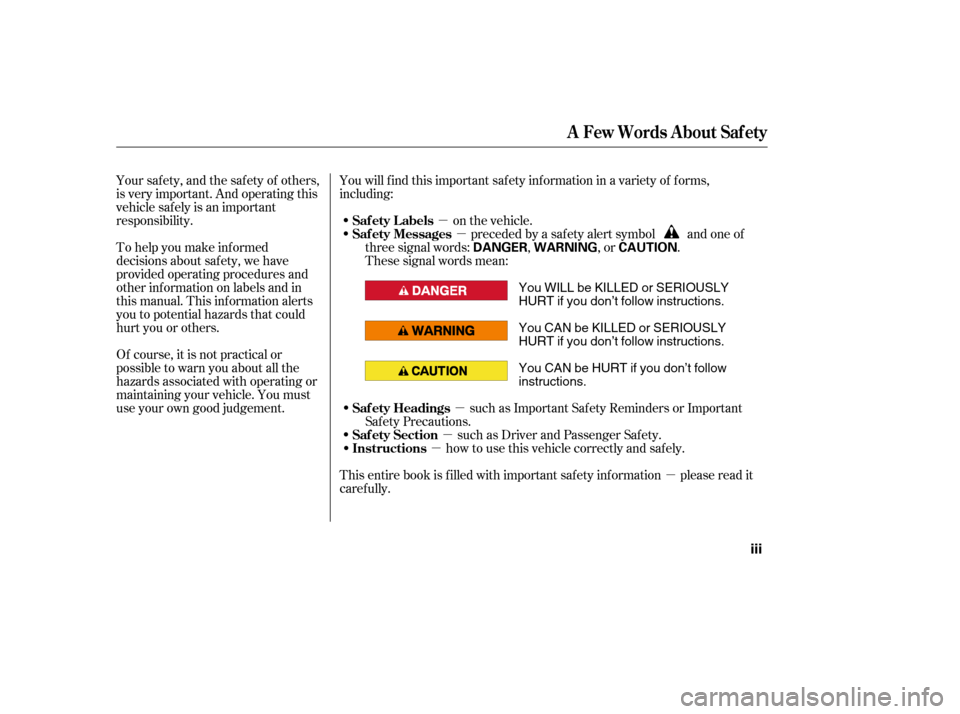Page 10 of 413
�µ
To remind you of the passenger’s
f ront airbag hazards, and that
children must be properly restrained
in a back seat, your vehicle has
warninglabelsonthedashboard
(U.S. models) and on the f ront visors.
Please read and follow the
instructions on these labels.U.S. ModelsCanadian Models
Protecting Children General Guidelines
34
SUN VISOR
SUN VISOR
DASHBOARD
�����—�����—�
�
�y�
����
�
������y���
�(�+���������y���������y
Page 21 of 413

This indicator normally comes on f or
a f ew seconds when you turn the
ignition switch to the ON (II)
position. If it comes on at any other
time, there is a problem with the
ABS. If this happens, have your
vehicle checked at a dealer. With
this indicator on, your vehicle still
has normal braking ability but no
anti-lock f unction. For more
inf ormation, see page .When you press the hazard warning
button, both turn signal indicators
and all turn signals on the outside of
the vehicle f lash.
This indicator comes on brief ly when
you turn the ignition switch to the
ON (II) position. It will then go of f if
you have inserted a properly-coded
ignition key. If it is not a properly-
coded key, the indicator will blink,
and the engine’s f uel system will be
disabled (see page ).
The lef t or right turn signal indicator
blinks when you signal a lane change
or turn. If an indicator does not blink
or blinks rapidly, it usually means
one of the turn signal bulbs is
burned out (see pages and ).
Replace the bulb as soon as possible,
since other drivers cannot see that
you are signaling.
214 77
249 250
Instrument Panel Indicators
Anti-lock Brake System
(A BS) Indicator
Turn Signal and Hazard Warning
Indicators
Immobilizer System
Indicator
Inst rument s and Cont rols
59
�����—�����—�
�
�y�
����
��������y���
�(�+���������y���������y
Page 59 of 413

The tires on your vehicle meet all
U.S. Federal Saf ety Requirements.
All tires are also graded f or
treadwear, traction, and temperature
perf ormance according to
Department of Transportation
(DOT) standards. The f ollowing
explains these gradings.
Quality grades can be f ound where
applicable on the tire sidewall
between tread shoulder and
maximum section width. For
example:The treadwear grade is a compara-
tive rating based on the wear rate of
the tire when tested under controlled
conditions on a specif ied government
test course. For example, a tire
graded 150 would wear one and one-
half (1 1/2) times as well on the
government course as a tire graded
100. The relative perf ormance of
tires depends upon the actual condi-
tions of their use, however, and may
depart signif icantly f rom the norm
due to variations in driving habits,
service practices and dif f erences in
road characteristics and climate.The traction grades, f rom highest to
lowest, are AA, A, B, and C. Those
grades represent the tire’s ability to
stop on wet pavement as measured
under controlled conditions on
specif ied government test surf aces
of asphalt and concrete. A tire
marked C may have poor traction
perf ormance.
All passenger car tires must conf orm
to Federal Saf ety Requirements in
addition to these grades. Warning: The traction grade
assignedtothistireisbasedon
straight-ahead braking traction tests,
and does not include acceleration,
cornering, hydroplaning, or peak
traction characteristics.
Unif orm T ire Quality Grading
T readwear 200
Traction AA
Temperature A T readwear T raction
DOT T ire Quality Grading (U.S. Vehicles)
T echnical Inf ormation
299
�����—�����—�
�
�y�
�����������
�y���
�(�+���������y���������y
Page 62 of 413

Calif ornia Proposition 65 WarningThis product contains or emits chemicals known to the State of Calif ornia to cause cancer and birth
def ects or other reproductive harm.
Event Data Recorders
This data belongs to the vehicle owner and may not be accessed by anyone else
except as legally required or with the permission of the vehicle owner.
Service Diagnostic Recorders
This vehicle is equipped with service-related devices that record inf ormati on about powertrain perf ormance. The data
can be used to verif y emissions law requirements and/or help technicians diagnose and solve ser vice problems. It may
also be combined with data f rom other sources f or research purposes, but it remains conf i dential.
Introduction
WARNING:
This vehicle is equipped with one or more devices commonly ref erred to as event data recorders. These
devices record f ront seat belt use, f ront passenger seat occupancy, air bag deployment data, and the f ailure
of any airbag system component.
ii
�����—�����—�����y�������������
�y���
�(�#���������y���������y
Page 63 of 413

�µ
�µ
�µ
�µ
�µ
�µ
To help you make inf ormed
decisions about saf ety, we have
provided operating procedures and
other inf ormation on labels and in
this manual. This inf ormation alerts
you to potential hazards that could
hurt you or others. You will f ind this important saf ety inf ormation in a variety of f orms,
including:
preceded by a saf ety alert symbol and one of
three signal words: , , or .
These signal words mean:
such as Important Saf ety Reminders or Important
Safety Precautions. such as Driver and Passenger Safety.
how to use this vehicle correctly and safely.
This entire book is f illed with important saf ety inf ormation please read it
caref ully.
Your safety, and the safety of others,
is very important. And operating this
vehicle safely is an important
responsibility.
Of course, it is not practical or
possible to warn you about all the
hazards associated with operating or
maintaining your vehicle. You must
use your own good judgement.
on the vehicle.
Saf ety Messages
Saf ety Headings
Saf ety Section
Instructions
Saf ety L abels
AFewWordsAboutSafety
DANGER WARNING CAUTION
iii
You WILL be KILLED or SERIOUSLY
HURT if you don’t follow instructions.
You CAN be KILLED or SERIOUSLY
HURT if you don’t follow instructions.
You CAN be HURT if you don’t follow
instructions.
�����—�����—�����y��������
������y���
�(�#���������y���������y
Page 67 of 413
�Î�Î
�Î
�Î
�Î
�Î
�Π��ΠOnly on vehicles equipped with navigation system. Ref er to the navigati
on system manual.
To use the horn, press the center pad of the steering wheel.
If equipped
1:2:3:
Your Vehicle at a Glance
4
HEADLIGHTS/TURN SIGNALS
STEERING WHEEL
ADJUSTMENT WINDSHIELD WIPERS/WASHERS
(P. 71)
(P. 72)
Vehicle with navigation system is shown. (P. 75)HORN
CRUISE CONTROL BUTTONSPASSENGER AIRBAG OFF
INDICATOR
(P. 30)
HAZARD WARNING BUTTON
(P. 74)
REAR WINDOW DEFOGGER
(P. 74)
HEATED MIRRORS
INSTRUMENT PANEL
BRIGHTNESS BUTTONS
(P. 73)
DISPLAY CHANGE
BUTTON
(P. 66)
SEL/RESET
BUTTON
VEHICLE STABILITY
ASSIST (VSA) SYSTEM
OFF SWITCH
REMOTE AUDIO
CONTROLS
VOICE CONTROL
SWITCHES
HOOD RELEASE HANDLE
(P. 182)
(P. 66)
(P. 211)
(P. 171)
(P. 176)(P. 103)
1 2
2
2
2
3
�����—�����—�����y��������
������y���
�(�#���������y���������y
Page 68 of 413

�µ
You’ll f ind many saf ety
recommendations throughout this
section, and throughout this manual.
Therecommendationsonthispage
are the ones we consider to be the
most important.
A seat belt is your best protection in
all types of collisions. Airbags are
designed to supplement seat belts,
not replace them. So even though
your vehicle is equipped with airbags,
make sure you and your passengers
always wear your seat belts, and
wear them properly (see page ).
Alcohol and driving don’t mix. Even
one drink can reduce your ability to
respond to changing conditions, and
your reaction time gets worse withevery additional drink. So don’t drink
and drive, and don’t let your f riends
drink and drive, either.
While airbags can save lives, they
can cause serious or fatal injuries to
occupants who sit too close to them,
or are not properly restrained.
Inf ants, young children, and short
adults are at the greatest risk. Be
sure to f ollow all instructions and
warnings in this manual.
Children age 12 and under should
ride properly restrained in a back
seat, not the front seat. Infants and
smallchildrenshouldberestrained
in a child seat. Larger children
should use a booster seat and a lap/
shoulder belt until they can use the
belt properly without a booster seat
(see pages ).
Excessive speed is a major f actor in
crash injuries and deaths. Generally,
the higher the speed, the greater the
risk, but serious injuries can also
occur at lower speeds. Never drive
f aster than is saf e f or current
conditions, regardless of the
maximum speed posted.
Having a tire blowout or a
mechanical f ailure can be extremely
hazardous. To reduce the possibility
of such problems, check your tire
pressures and condition f requently,
and perform all regularly scheduled
maintenance (see page ).
14
33 50
223
Important Saf ety Precautions
Always Wear Your Seat Belt
Don’t Drink and Drive
Be Aware of Airbag Hazards
Restrain All Children
Control Your Speed
K eep Your Vehicle in Saf e
Condition
6
�����—�����—�����y���������������y���
�(�#���������y�����
�
�y
Page 106 of 413
�µ
To remind you of the passenger’s
f ront airbag hazards, and that
children must be properly restrained
in a back seat, your vehicle has
warninglabelsonthedashboard
(U.S. models) and on the f ront visors.
Please read and follow the
instructions on these labels.
Canadian Models
U.S. Models
Protecting Children General Guidelines
Driver and Passenger Saf ety
35
Dashboard
Sun Visor
Sun Visor
�����—�����—�����y���������������y���
�(�#���������y���������y